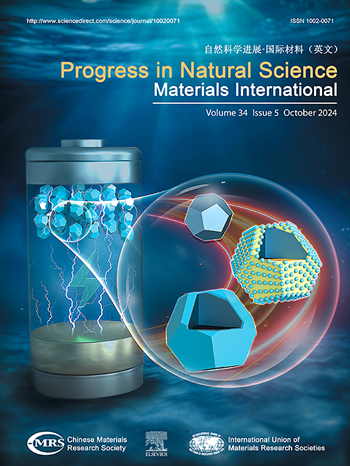Grain refinement and phase precipitation simultaneously improve the strength and ductility of ultra-high strength titanium alloy sheets
IF 4.8
2区 材料科学
Q2 MATERIALS SCIENCE, MULTIDISCIPLINARY
Progress in Natural Science: Materials International
Pub Date : 2024-10-01
DOI:10.1016/j.pnsc.2024.08.001
引用次数: 0
Abstract
The simultaneous high strength and high plasticity of metastable-β titanium alloy sheets remains a difficult challenge. In this work, a 1.2 mm thick sheet of Ti–15Mo–3Al-2.7Nb-0.25Si titanium alloy was obtained after rolling and annealing, and then subjected to a duplex-ageing treatment. The pre-ageing temperatures fell in the range of 300–390 °C for 0.5–2h. The re-ageing temperatures were in the range of 500–600 °C. After characterization, it was found that the alloy precipitates ω-phases during the pre-ageing process, and the distribution of such ω-phases evolves unevenly and increases in number with the increase of the pre-ageing temperature. Therefore, the strengthening mechanism of the alloy sheet is mainly α-phase nucleation assisted by ω-phase. Moreover, grain refinement appears as a mechanism to ensure the plasticity of the alloy. Finally the ω-phase evolution law is discussed in detail and the strengthening mechanism of the alloy sheet is also analyzed. At this work, a metastable-β titanium alloy sheet with strength of 1445.75 MPa and elongation of 6.55 % was obtained. This study provides a new idea for the microstructure design and process improvement of the metastable-β titanium alloy sheet.
晶粒细化和相析出同时提高超高强度钛合金板的强度和延展性
同时获得高强度和高塑性的易变-β钛合金板材仍然是一项艰巨的挑战。在这项研究中,钛-15Mo-3Al-2.7Nb-0.25Si钛合金板材经轧制和退火后厚度为 1.2 mm,然后进行双相时效处理。预时效温度为 300-390 °C,时间为 0.5-2 小时。再时效温度为 500-600 ℃。表征后发现,合金在预时效过程中会析出ω相,且这种ω相的分布不均匀,数量随预时效温度的升高而增加。因此,合金薄片的强化机制主要是α相在ω相辅助下成核。此外,晶粒细化也是确保合金塑性的一种机制。最后,详细讨论了ω相的演化规律,并分析了合金薄片的强化机制。在这项工作中,获得了强度为 1445.75 兆帕,伸长率为 6.55 % 的可蜕变-β 钛合金薄板。这项研究为可转移-β钛合金板材的微观结构设计和工艺改进提供了新思路。
本文章由计算机程序翻译,如有差异,请以英文原文为准。
求助全文
约1分钟内获得全文
求助全文
来源期刊
CiteScore
8.60
自引率
2.10%
发文量
2812
审稿时长
49 days
期刊介绍:
Progress in Natural Science: Materials International provides scientists and engineers throughout the world with a central vehicle for the exchange and dissemination of basic theoretical studies and applied research of advanced materials. The emphasis is placed on original research, both analytical and experimental, which is of permanent interest to engineers and scientists, covering all aspects of new materials and technologies, such as, energy and environmental materials; advanced structural materials; advanced transportation materials, functional and electronic materials; nano-scale and amorphous materials; health and biological materials; materials modeling and simulation; materials characterization; and so on. The latest research achievements and innovative papers in basic theoretical studies and applied research of material science will be carefully selected and promptly reported. Thus, the aim of this Journal is to serve the global materials science and technology community with the latest research findings.
As a service to readers, an international bibliography of recent publications in advanced materials is published bimonthly.

 求助内容:
求助内容: 应助结果提醒方式:
应助结果提醒方式:


